Rob's introductionAs a beginning gardener, I was always sure to check out the Shade Gardening columns on Suite 101, written by Marge Talt. One article that I found myself referring back to again and again was the one on the genus Pinellia. So when I found recently that it had disappeared from Suite101.com, I was eager to get the information back online. With Marge's permission, the original article is reproduced below. I removed some links to resources that are no longer available, and tweaked the layout to fit with robsplants.com – the rest is all Marge's!
Wild, Wonderful Aroids
|
|||||||||||||||||||||||||||||||||||||||
| pedate Palmately divided or parted. |
This is the tallest of the Pinellia species, reaching nearly fifteen inches in height (35 cm). The central leaflet is always the longest and can reach about four inches (10 cm) in length.
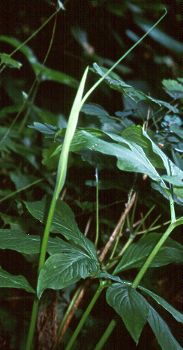
The inflorescence is the largest of four
Pinellia species in common cultivation, reaching four to seven inches
(10-18 cm) in length.
| filiform (syn. thread-like) Thread-shaped; long, slender, with a circular cross section. |
New inflorescences are formed continuously during the growing season. Each quite capable of producing a viable seed, which is why this species is an enthusiastic spreader when in a happy location.
Fan-leaf Chinese green-dragon is the only common name I've run into for this species and it may be a rather fanciful one, dreamed up by the nursery listing it, since that's the only place I found it.
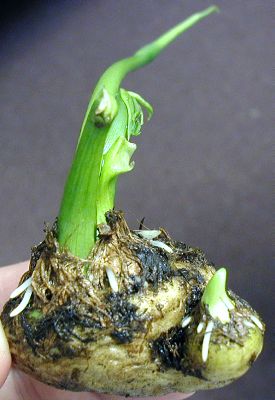
This poor tuber was found laying on its side on top of the soil, the victim of one of our local squirrel digging contests, no doubt. The spathe had started to grow toward the light at an acute right angle.
You can see how the roots emerge from the top of the tuber.
The blackish bits are remnants of the papery tuber covering; the brownish
bits the remainder of old roots.
Safely potted up after its photo session, it's now straightening out, spath pointed skyward, as it should be.
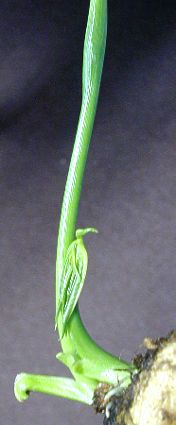
Turned upright here, you
can see the spathe elongating and the unfolding leaf below it.
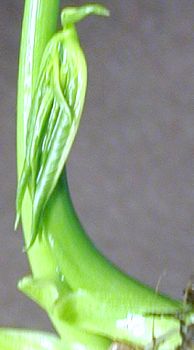
We are not often given the opportunity to observe the unfolding of a leaf; we hurry past this little miracle, bent on weeding, planting or pruning and don't notice what is happening at ground level.
Nature's tidy packaging always amazes me.
Whether a leaf, flower, the crosier of a fern or the emerging embryo of a
seed, all the parts are there in miniature, intricately folded.
Pinellia tripartita
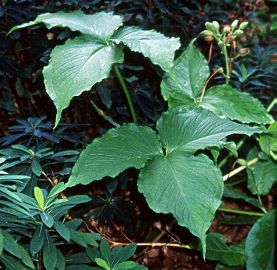 P. tripartita, from southern Japan, is much
better behaved in the same bed as P. pedatisecta. It has seeded
around a bit, but by no means excessively.
P. tripartita, from southern Japan, is much
better behaved in the same bed as P. pedatisecta. It has seeded
around a bit, but by no means excessively.
The distinctive, polished foliage remains pristine all season. Give it a ring-side seat so you can enjoy it.
Each leaflet can range from three to
eight inches (8 - 20 cm) in length on plants that can reach eighteen inches
tall (45 cm) when fully mature, but are generally closer to a foot (30cm)
tall.
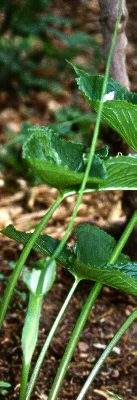
The three to four inch (8-10 cm) spath is often
somewhat hidden by the foliage, unlike that of P. pedatisecta, but
the spadix rises another six to ten inches (15 - 25cm) until late summer
when it droops back to the ground.
There are two forms of P. tripartita that are on my lust list.
|
Pinellia tripartita 'Atropurpurea' differs from the species only in the marvelous purple interior spathe color. |
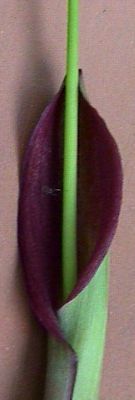
|
 |
Pinellia tripartita 'Polly Spout' features a delicate pink spathe interior that George Schmid says, in his Encyclopedia of Shade Perennials, stands out like a pink flag. |
One source notes that the main difference between P. tripartita 'Atropurpurea' and the species is Atropurpurea's "strong affinity to attracting gnats (or small flies) as pollinators, which seem to perish once entrapped in the lower chamber" of the spathe. I wonder if this is related to the red spathe interior color?
Pinellia cordata
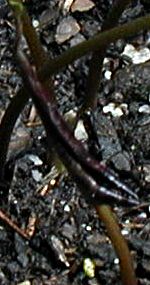
I just acquired P. cordata 'Yamazaki'
this spring, from Ellen Hornig's Seneca Hill Perennials, as a dormant tuber.
Native to China and Korea, P. cordata is considered by many to be the best of the species in cultivation. The clone 'Yamazaki', named in honor of its originator in Japan, is said to be larger than the species with better patterned leaves.
As soon as it started to awaken, I fell in love. Two cravings - purple foliage and variegated foliage - were satisfied in one neat package.
From tiny tubers arise shiny, deep purple, tightly rolled leaves on dusky
petioles.
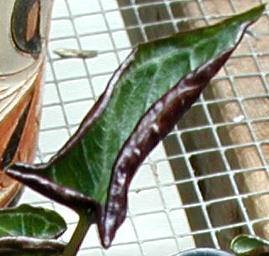
As the leaf unfolds, the white vein markings become visible.
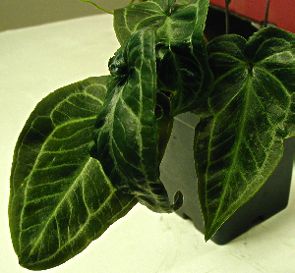
Fully open, the dark green, glossy heart-shaped leaves (hence the 'cordate' in the name) resemble some forms of Cyclamen in their markings or one of the Asian hardy gingers. The leaves reach three to five inches (8-13cm) long and about half as wide.
The relatively long leaf petioles (stems) - to eight inches (20 cm) - remain a dusky purple.
Just planted in the garden, I see that the leaves are not erect, so that the overall plant height appears closer to six inches (15cm).
Dan Hinkley, in his The Explorer's Garden notes that he has some seedlings of P. cordata with entirely green leaves. While charming, I'm sure, I want the variegation!
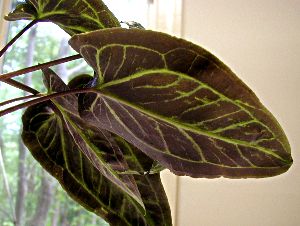 Even more exciting is the underside of the leaf - deep purple
with green vein markings! Oh, be still my heart! This plant thrills me to
the core.
Even more exciting is the underside of the leaf - deep purple
with green vein markings! Oh, be still my heart! This plant thrills me to
the core.
Unfortunately, it's said to be much slower increasing than other species. I'm hoping "they" are incorrect because I can't have too much of this child. I will be looking for the leaf stem bulbils to plant on and increase stock as quickly as I can, since it is said to be reluctant to set seed in the garden.
This may not be quite as hardy as some of the species although it is being grown outside with no mulch in Milwaukee, Wisconsin (zone 5b) where temperatures have reached -10°F / -23°C.
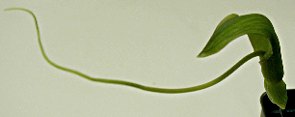 The tiny spathe, only about three inches in length (7-8
cm), peeks out from beneath the leaves and pops up between them.
The tiny spathe, only about three inches in length (7-8
cm), peeks out from beneath the leaves and pops up between them.
The thread-like spadix curves out from the mouth of the spathe for almost
four inches (10cm) and then points up.
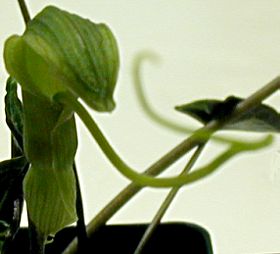
On one spathe on my plants, the spadix
corkscrewed away from the spathe. "Cute" is an apt descriptive adjective
for this tiny tot.
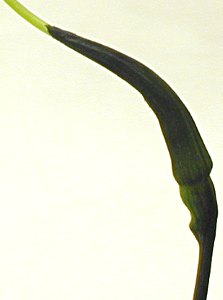
The inflorescence is said to have an apple, pineapple or bubble gum fragrance. I can't say that I noticed anything, but often spathe scent is illusive or only lasts a few hours upon opening.
The spadix emerges from the tip of a tightly furled new spathe.
I am glad that my plants were in a pot when they
first emerged. Had I planted the dormant tuber in the garden, it's likely
that, in the hurly-burly of spring gardening, I would have missed seeing the
foliage unfold and watching the progress of leaf growth; both fascinating
processes.
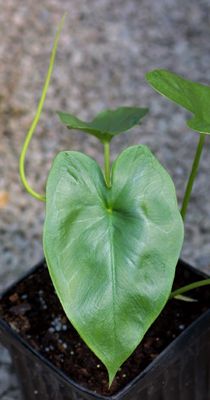
Some sources insist that P. cordata is the only species with an undivided leaf. They are wrong. Pinellia peltata has a similar leaf shape without the vein markings.
If you don't have any of the Wild, Wonderful Aroids in your shady garden, you owe it to yourself to get one (any of them but P. ternata!)...you'll be glad you did. See ya' later!
More Information
Where to find Pinellia. The following nurseries usually offer one or more selections of Pinellia species and cultivars. Check their websites for current offerings:
- Plant Delights Nursery
- Collector's Nursery
- Fraser's Thimble Farms in B.C., Canada
Image Credits
All graphics are by Marge. All photos, except the following, were taken by Marge: P. tripartita 'Atropurpurea', P. tripartita 'Polly Spout' and P. peltata are copyright Allan Galloway; used with his kind permission . Do not use these images without written permission from their owner!
I welcome comments about my web pages; feel free to use the form below to leave feedback about this particular page. For the benefit of other visitors to these pages, I will list any relevant comments you leave, and if appropriate, I will update my page to correct mis-information. Note that I discard any comments including html markups, so please submit your comment as plain text. If you have a comment about the website as a whole, please leave it in my guestbook. If you have a question that needs a personal response, please e-mail me.
| home | garden | plants | wildlife | seed | plant sale | topics | guestbook | journal | plantlinks |
Last modified:
October 15, 2012
Contact me
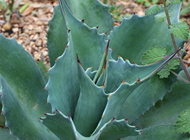
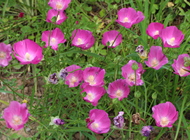

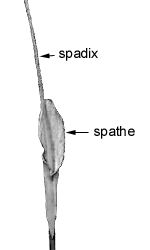
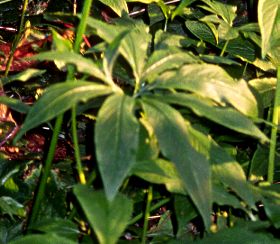 Of the three species I grow,
P. pedatisecta, from northern and western China and Japan, is
the most vigorous. It loves the bed of rotted woodchips it's in and
reproduces speedily via seed. In the soft medium, it's very easy to scoop
out unwanted plants. I've put a couple in less salubrious soil to see what
they do there...so far it's curbed their enthusiasm a bit.
Of the three species I grow,
P. pedatisecta, from northern and western China and Japan, is
the most vigorous. It loves the bed of rotted woodchips it's in and
reproduces speedily via seed. In the soft medium, it's very easy to scoop
out unwanted plants. I've put a couple in less salubrious soil to see what
they do there...so far it's curbed their enthusiasm a bit.